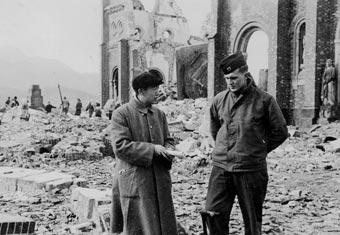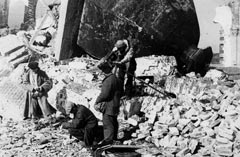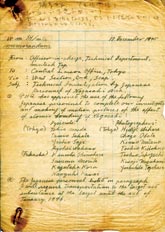Production under American Supervision and Confiscation of the Film
Just as filming started in Hiroshima and Nagasaki during the latter part of September, the allied forces instituted occupation policies within Japan. Although filming continued without major problems in Hiroshima, it was interrupted in Nagasaki by the U.S. Army, then forcibly terminated. After returning to Tokyo, the film teams negotiated with the U.S. Army through Yoshio Nishina, the film's supervisor, and the Ministry of Education in an attempt to restart the filming. On December 17, the Supreme Commander of the Allied Forces (SCAP) ordered the film teams to surrender all footage. Hidetsugu Aihara appeared at General Headquarters to explain that the film was still unedited and a great deal of work was left to be done. He pleaded for the Japan Film Corporation to be allowed to complete the film. The U.S. considered his plea, but decided to commission the United States Strategic Bombing Survey to complete the film project.

[46] |
[46]
Resumption of filming in Nagasaki
December 1945 to January 1946 Motoo-machi, Nagasaki City Urakami Cathedral
500m from the hypocenter Courtesy of Katsu Obata
In order to perform secondary filming in Nagasaki, the production staff and academic survey team investigators departed Tokyo Station on December 22. In Nagasaki, U.S. Army personnel accompanied the group during the filming, but did not interfere with the work. Filming continued until the latter part of January of the next year. |

[47]
Filming at Urakami Cathedral
December 1945 to January 1946 Motoo-machi, Nagasaki City Urakami Cathedral
500m from the hypocenter Courtesy of Katsu Obata
In this photograph the bell tower of heavily damaged Urakami Cathedral can be seen behind the production staff's camera. In Nagasaki, filming covered radiation measurements, heat, and other themes similar to those covered in Hiroshima. After filming was completed, the group flew back to Tokyo. Along the way, it filmed the city of Hiroshima from the air. |

[48]
Approval for filming in Nagasaki
Donated by Peace Museum of Saitama (from “Material provided by Hidetsugu Aihara”)
On December 17, submission of the footage from the film was ordered, and continuation of the film's production was at risk. As a result of negotiations, however, approval for the film in a form commissioned by the U.S. Strategic Bombing Survey was granted. Investigating and filming in Nagasaki was approved for the film's production, and various accommodating actions were requested during the staff's stay. |



